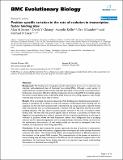Position specific variation in the rate of evolution in transcription factor binding sites
Author(s)
Kellis, Manolis; Moses, Alan M.; Chiang, Derek Y.; Eisen, Michael B.; Lander, Eric Steven
Download1471-2148-3-19.pdf (375.6Kb)
PUBLISHER_CC
Publisher with Creative Commons License
Creative Commons Attribution
Terms of use
Metadata
Show full item recordAbstract
Background: The binding sites of sequence specific transcription factors are an important and relatively well-understood class of functional non-coding DNAs. Although a wide variety of experimental and computational methods have been developed to characterize transcription factor binding sites, they remain difficult to identify. Comparison of non-coding DNA from related species has shown considerable promise in identifying these functional non-coding sequences, even though relatively little is known about their evolution. Results: Here we analyse the genome sequences of the budding yeasts Saccharomyces cerevisiae, S. bayanus, S. paradoxus and S. mikatae to study the evolution of transcription factor binding sites. As expected, we find that both experimentally characterized and computationally predicted binding sites evolve slower than surrounding sequence, consistent with the hypothesis that they are under purifying selection. We also observe position-specific variation in the rate of evolution within binding sites. We find that the position-specific rate of evolution is positively correlated with degeneracy among binding sites within S. cerevisiae. We test theoretical predictions for the rate of evolution at positions where the base frequencies deviate from background due to purifying selection and find reasonable agreement with the observed rates of evolution. Finally, we show how the evolutionary characteristics of real binding motifs can be used to distinguish them from artefacts of computational motif finding algorithms. Conclusion: As has been observed for protein sequences, the rate of evolution in transcription factor binding sites varies with position, suggesting that some regions are under stronger functional constraint than others. This variation likely reflects the varying importance of different positions in the formation of the protein-DNA complex. The characterization of the pattern of evolution in known binding sites will likely contribute to the effective use of comparative sequence data in the identification of transcription factor binding sites and is an important step toward understanding the evolution of functional non-coding DNA.
Date issued
2003-08Department
Massachusetts Institute of Technology. Department of Biology; Massachusetts Institute of Technology. Laboratory for Computer ScienceJournal
BMC Evolutionary Biology
Publisher
BioMed Central Ltd
Citation
Moses, Alan M., Derek Y. Chiang, Manolis Kellis, Eric S. Lander, and Michael B. Eisen (2003). Position specific variation in the rate of evolution in transcription factor binding sites. BMC evolutionary biology 3:19/1-13.
Version: Final published version
ISSN
1471-2148
Keywords
Artifacts, Base composition, Base sequence, Binding sites, genetics, Computational biology, methods, Computational biology, statistics & numerical data, Conserved sequence, Evolution, molecular, Gene expression regulation, fungal, Genetic variation, Genome, fungal, Mutagenesis, Predictive value of tests, Promoter regions, genetic, Promoter regions, genetic, physiology, Saccharomyces, genetics, Saccharomyces cerevisiae, genetics, Transcription factors, genetics, Transcription factors, metabolism, Transcription, genetic